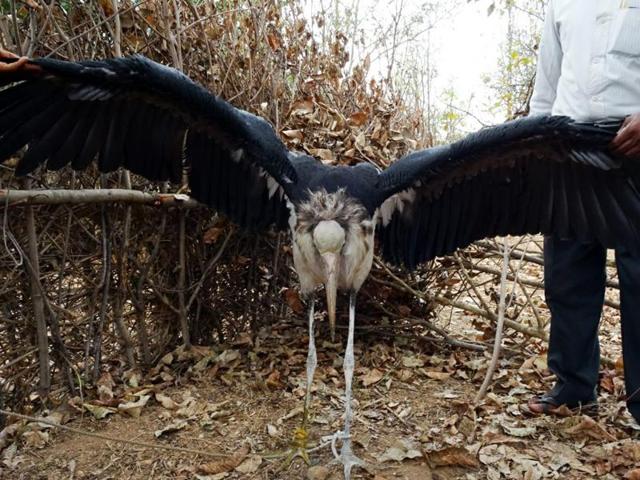Injured Garuda in Jharkhand reveals threat to the rare bird
Forest officials have rescued an injured Garuda bird (lesser adjutant stork) from Barkagaon village in Chatra district of Jharkhand, raising fears of poaching of the rare winged species
Forest officials have rescued an injured Garuda bird (lesser adjutant stork) from Barkagaon village in Chatra district of Jharkhand, raising fears of poaching of the rare winged species.

“The bird was hit by stones. It’s legs had injuries. We have sent the bird for cure and care to Ranchi zoo,” said Madhukar, divisional forest officer of Chatra South division. Zoo officials received the bird, considered the mount (vahana) of Lord Vishnu in Hindu mythology, on Sunday evening.
The lesser adjutant is placed in the vulnerable category -- the red list for birds -- of the International Union for Conservation of Nature (IUCN). “Weight of the bird is around 10kg and it has a wing span of five feet,” Madhukar said, adding that the bird was rarely sighted in a few water bodies in Jharkhand. “Our team is investigating who injured the bird,” he said.
KK Sharma, in-charge of the Jharkhand-Bihar chapter of the Ornithology Society of India, said the bird became rare in the state because of food shortage and poaching.
“In Jharkhand villages, the bird is poached for two reasons -- meat and superstition. The bird’s beak and bone are kept in houses with a misconception that they bring fortunes,” Sharma said.
“Population of the bird is dwindling rapidly in the world due to habitat loss, anthropogenic pressure, decreasing wetland feeding areas, intensive fishing and increased use of pesticides,” said Satya Prakash, state convener of Bombay Natural History Society (BNHS).
The global population of the bird is estimated at 6,500 to 8,000, according to the Birdlife International-2013. In India, the bird is found in Assam, West Bengal, Bihar, Odisha, Tamil Nadu, Karnataka and a few pockets of Jharkhand.
The population of lesser adjutant in Jharkhand is estimated at 35-40. “A breeding centre of the bird was identified in Peterwar area of Bokaro district about three years back where its population is rising. In 2013, we had estimated 15 birds in the area but the number has increased to more than 25 in the latest bird survey,” said Prakash, also the state coordinator of Asian Waterbird Census (AWC).
AWC is a part of a global waterbird-monitoring programme, coordinated by Wetlands International in association with BNHS. AWC in association with the forest department conducted a bird census between January 10 and February 6 in 25 water bodies of Jharkhand this year.
Besides Bokaro, lesser adjutant is also rarely sighted in Khunti, Chaibasa, Lohardaga, Chaibasa and Sahebganj.
BNHS has been campaigning to protect the species in Jharkhand. “The bird sets its nests in tamarind and Indian banyan trees. We have been talking to the villagers not to cut such trees and never kill the birds, as they are vanishing from the world,” Prakash said, adding the bird population has increased in Bokaro because of the awareness programme.




